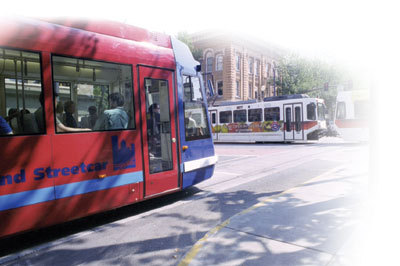CMAQ Cost: $840,000
Total Project Cost: $950,000
Portland has a strong history of supporting pedestrian access. In 1994, Metro, the regional government of the Portland metropolitan area, adopted a 50-year regional growth-and-development concept that calls for "development of a true multimodal transportation system which serves land use patterns, densities and community designs that allow for and enhance transit, bike, pedestrian travel and freight movement." 30 Compared to many other large cities, Portland has a high share of nonmotorized travel. Nearly 12 percent of the trips in downtown Portland are made by people who walk to transit. Easy street crossings, sidewalk continuity, street connectivity, and topography of the inner, older neighborhoods facilitate pedestrian access.
As with most North American cities, however, the city of Portland has its share of edge communities developed around automobile transportation, where streets were built with suburban design features. Some streets lack sidewalks, have wide lanes and streets with higher vehicular speeds, incorporate few pedestrian amenities, or have intersections configured to optimize vehicular turning movements rather than pedestrian crossings. An inventory of sidewalks and curb ramps conducted for the Portland Pedestrian Master Plan showed that these areas were largely lacking pedestrian facilities, even on arterial streets. A travel behavior survey conducted by Metro in 1994 also found that about 28 percent of all trips in inner, mixed-use areas were made on foot, compared to only 5 percent in suburban areas in the region.31
Because transit riders generally begin and end their trips as pedestrians, the Portland Office of Transportation was interested in understanding how the pedestrian environment affects transit use. It recognized that even though the region had a good transit system, an unattractive or unsafe walking environment discourages people from using transit. Given a projection of regional population growing by about 50 percent between 1994 and 2020, increasing transit use was seen as an important component of the regional transportation plans.32

The Portland Office of Transportation initiated a study and demonstration project to look at one such factor: improving pedestrian access to transit. The study asked whether improving pedestrian access would encourage transit use, especially among "choice" riders (riders who have access to cars and therefore do not have to ride transit).
The project proceeded in three phases: the study itself, planning and design, and a demonstration. During the study phase, planners identified neighborhoods with high numbers of choice riders not using transit, asked residents why they did not use transit, and identified five factors influencing transit use: continuous path to stops, personal safety, shorter pedestrian routes, comfort, and understanding of the transit system. During the planning and design phase, planners developed design guidelines for five types of areas: primary transit stops, secondary transit stops, neighborhood transit areas (the area between the stop and the nearest intersections), primary pedestrian routes, and special conditions (such as retail/commercial areas or uncurbed streets).
Finally, during the demonstration phase a number of pedestrian improvements were made in the Roseway neighborhood in northeast Portland. These improvements included curb extensions, bus shelters, pedestrian refuge islands, new sidewalks and corner curb ramps, street lighting, and tree planting and landscaping. The demonstration project was completed in 1998.

Telephone surveys with 178 neighborhood residents made before and after the improvements showed that there was a positive impact on transit usage. The surveys suggested about a 10 percent increase in transit trips within the study area (this finding is not statistically significant, however, given the small sample size). The benefits of the improvements extended beyond increasing the number of transit trips taken by residents. The pedestrian improvements facilitated walking trips for various purposes, many of which did not involve transit. The project had a clear impact on the residents' sense of safety while using the pedestrian network; it also supported increased mobility for all ages and physical capabilities.
Portland has emphasized these type of transit access improvements as it has expanded its light rail system, including promoting transit-oriented development around stations as a way to provide increased access to housing, jobs, and shopping via transit. The City of Portland is committed to providing the benefits of walking to all residents by supporting pedestrian travel as a safe, efficient, desirable, and accessible mode throughout the city's neighborhoods, and in 1998, developed a Pedestrian Master Plan to guide priorities for the city.
6 kg/day VOC, 8 kg/day NOx, 29 kg/day CO
Bill Hoffman
Portland Office of Transportation
503-823-7219
30 Metro Region 2040 Plan, Portland, OR. On-line at: www.metro-region.org/.
31 Metro Household Activity Survey, 1994. (This modal share figure is for walk-only trips; it does not include walk-to-transit trips, which are counted as part of the transit modal share.)
32 Metro Region 2040 Plan. Portland, OR. On-line at: www.metro-region.org/.